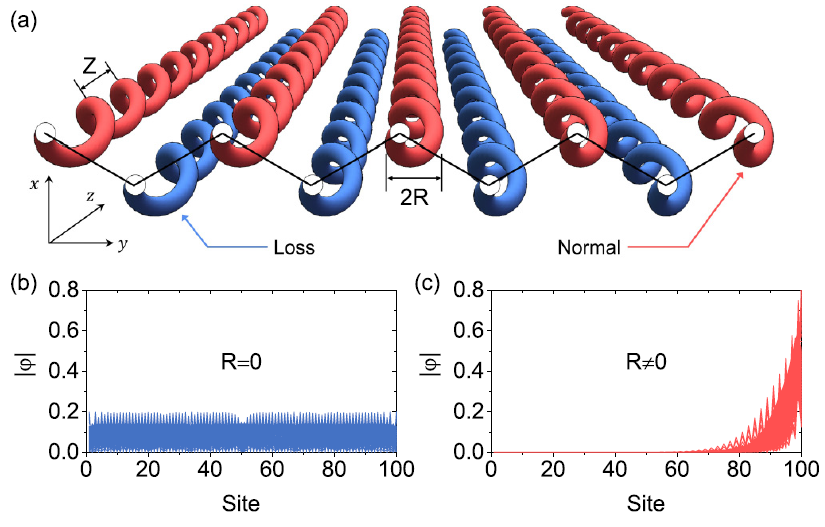Recently, a research group led by Prof. Yong-Chun Liu from Department of Physics have proposed a mechanism utilizing periodic couplings to realize the loss-induced non-Hermitian skin effect. This work was published in Physical Review B as a Letter under the title of "Loss-induced Floquet non-Hermitian skin effect" and was selected to be an Editors’ Suggestion.
Non-Hermitian systems are open systems that can be described by non-Hermitian Hamiltonians. There are many novel properties in non-Hermitian systems, one of which is the non-Hermitian skin effect. In this effect, all the eigenstates are localized to one of the system boundaries, and the conventional bulk-edge correspondence is broken down. In theory according to the form of the non-Hermiticity, the non-Hermitian systems can be mainly divided into two categories: systems with gain/loss and systems with nonreciprocal couplings. The non-Hermitian skin effects are predicted in both two kinds of systems through distinct mechanism. However, most existing experimental works that realized the non-Hermitian skin effect used the nonreciprocal couplings. In realistic systems, nonreciprocal couplings are usually difficult to achieve, but dissipation is widespread, and staggered dissipation distribution is equivalent to gain and loss. Therefore, it is of great significance to study the skin effect in gain-loss or pure lossy non-Hermitian systems.
The research team find the loss-induced non-Hermitian skin effect can be realized in Floquet systems without utilizing nonreciprocal couplings. The key of this mechanism is the Floquet-induced next-nearest neighbor couplings. This mechanism has two major advantages. First the experiment set-up, an array of helical waveguides, is very simple. There are only couplings between nearest-neighbor waveguides. They only need to introduce loss into specific waveguides, and the non-Hermitian skin effect can be realized. Second, this mechanism is appliable to one-dimensional and two-dimensional systems, can be used to realized first and second-order skin effects, and is appliable not only in helical waveguides but also in major quantum simulation systems, such as optical lattices and trap irons.

Fig.1. (a) Sketch of the non-Hermitian helical waveguides. The waveguides point to the z direction and are arranged in a zigzag structure along the y direction. There are two kinds of waveguides: the normal waveguides in red and the lossy waveguides in blue. The helical radius is R, and the pitch is Z. (b), (c) The profile of all the eigenstates of the effective coupling matrix. There is no non-Hermitian skin effect for straight waveguides (b), and there is the non-Hermitian skin effect towards the right for helical waveguides (c).
As shown in Fig. 1, this mechanism is easy to understand in one dimension. Furthermore, they also investigate how to realize the first and second-order non-Hermitian skin effects in two dimensions. Specifically, they propose two lattice structures: two-dimensional zigzag lattice and honeycomb lattice. The honeycomb lattice follows the idea of the Haldane model. After introducing the loss, they find this lattice can realize the hybrid skin-topological effect proposed by the research group last year [PRL 128, 223903 (2022)]. It is a second-order non-Hermitian skin effect. In this effect, only the topological edge states are further localized into a corner, while the bulk states remain extended. As for the two-dimensional zigzag lattice, after introducing the loss, they find this lattice can realize the first-order non-Hermitian skin effect, where all the eigenstates including bulk and topological edge states are localized into a corner.
They further develop a method to calculate the general Brillouin zone (GBZ) in non-Hermitian Floquet systems. The GBZ theory is a novel band theory that can restore the bulk-edge correspondence in non-Hermitian systems. But since the Floquet Hamiltonian is not accessible analytically, the conventional method fails in the nonequilibrium systems. Instead, they provide an alternative recipe for computing the GBZ, thereby extending its use to nonequilibrium systems. This method adopts contrary thinking to calculate the GBZ through its necessary properties instead of sufficient conditions.
The first author of the paper is graduate student Yaohua Li, and the corresponding author is associate professor Yong-Chun Liu, both from Department of Physics, Tsinghua University. The collaborator of the paper includes Prof. Lu Cuicui from School of Physics, Beijing Institute of Technology and Prof. Zhang Shuang from Department of Physics, University of Hong Kong.
Research link: https://journals.aps.org/prb/abstract/10.1103/PhysRevB.108.L220301